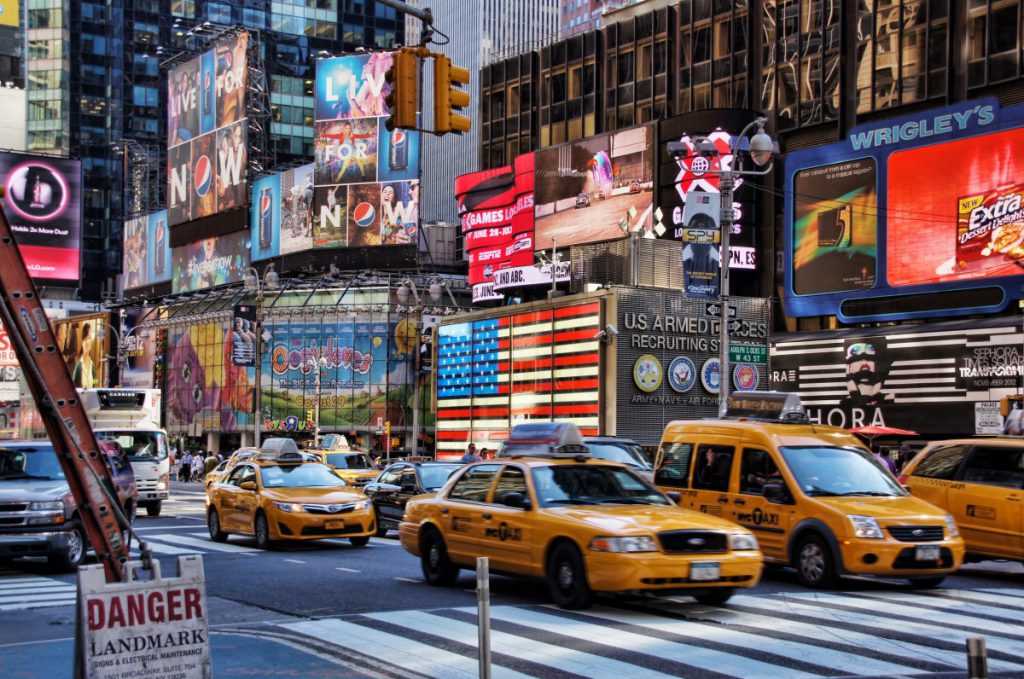State’s Early Infections Came From New York
78% of early COVID-19 infections in Wisconsin linked to New York City.

New York. (CCO Public Domain).
How was the COVID-19 virus spread to Wisconsin?
A new study reported by the New York Times shows people infected in the New York City area helped to spread the disease to places like Wisconsin. About 78 percent of all early cases in Wisconsin, based on analysis of genetic samples, came from “a line of the virus associated with the outbreak in New York City than from a line associated with the outbreak in Washington State.”
In the early days of the pandemic, before any state shutdowns had occurred, both Seattle and New York City appeared to be hot spots. “But the Seattle outbreak proved to be a squall before the larger storm gathering in New York, where, at the end of February, thousands of infected people packed trains and restaurants, thronged tourist attractions and passed through its three major airports,” the story noted.
“The research indicates that a wave of infections swept from New York City through much of the country before the city began setting social distancing limits to stop the growth,” the Times reports.
“We now have enough data to feel pretty confident that New York was the primary gateway for the rest of the country,” Nathan Grubaugh, an epidemiologist at the Yale School of Public Health, told the newspaper.
The report found that in Wisconsin 78 percent of the early coronavirus cases were related to New York City, with just 4 percent related to Seattle and Washington State.
Much of this presumably occurred through contact by Wisconsin visitors to New York City or by visitors to Wisconsin from NYC and its airports in January and February, before any efforts at social distancing were being made.
Over all, the report by Grubaugh estimated, “infections spreading from New York account for 60 to 65 percent of the sequenced viruses across the country.” The percent of cases related to New York ranged from 100 percent in Alaska, Iowa and Louisiana to more than 90 percent in East Coast states like New Jersey and Massachusetts to a low of 50 percent in West Coast states like Oregon and California to 45 percent in Illinois.
In three states closer to Seattle — Wyoming, Oregon and California — at least 30 percent of the early cases were linked to Washington State rather than New York. As for Illinois, its comparatively low percentage related to NYC may mean a significant percent of its cases came from O’Hare airport, one of the global leaders in international travel.
The data shows the nation’s slow response to an outbreak the World Health Organization declared a “Public Health Emergency of International Concern” on January 30th helped spread the disease to states across the nation, including Wisconsin.
“The central role of New York’s outbreak shows that decisions made by state and federal officials — including waiting to impose distancing measures and to limit international flights — helped shape the trajectory of the outbreak and allowed it to grow in the rest of the country,” the story noted.
“The city joins other densely populated urban hot spots around the world, starting with Wuhan, China, and then Milan, that have become vectors for the virus’s spread.
“…During crucial weeks in March, New York’s political leaders waited to take aggressive action, even after identifying hundreds of cases, giving the virus a head start. And by mid-March, when President Trump restricted travel from Europe, the restrictions were essentially pointless, the data suggest, as the disease was already spreading widely within the country.
“Acting earlier would most likely have blunted the virus’s march across the country, researchers say.”
“It means that we missed the boat early on, and the vast majority in this country is coming from domestic spread,” as Kristian Andersen, a professor in the department of immunology and microbiology at Scripps Research, told the newspaper.“I keep hearing that it’s somebody else’s fault. That’s not true. It’s not somebody else’s fault, it’s our own fault.”
If you think stories like this are important, become a member of Urban Milwaukee and help support real, independent journalism. Plus you get some cool added benefits.
More about the Coronavirus Pandemic
- Governors Tony Evers, JB Pritzker, Tim Walz, and Gretchen Whitmer Issue a Joint Statement Concerning Reports that Donald Trump Gave Russian Dictator Putin American COVID-19 Supplies - Gov. Tony Evers - Oct 11th, 2024
- MHD Release: Milwaukee Health Department Launches COVID-19 Wastewater Testing Dashboard - City of Milwaukee Health Department - Jan 23rd, 2024
- Milwaukee County Announces New Policies Related to COVID-19 Pandemic - County Executive David Crowley - May 9th, 2023
- DHS Details End of Emergency COVID-19 Response - Wisconsin Department of Health Services - Apr 26th, 2023
- Milwaukee Health Department Announces Upcoming Changes to COVID-19 Services - City of Milwaukee Health Department - Mar 17th, 2023
- Fitzgerald Applauds Passage of COVID-19 Origin Act - U.S. Rep. Scott Fitzgerald - Mar 10th, 2023
- DHS Expands Free COVID-19 Testing Program - Wisconsin Department of Health Services - Feb 10th, 2023
- MKE County: COVID-19 Hospitalizations Rising - Graham Kilmer - Jan 16th, 2023
- Not Enough Getting Bivalent Booster Shots, State Health Officials Warn - Gaby Vinick - Dec 26th, 2022
- Nearly All Wisconsinites Age 6 Months and Older Now Eligible for Updated COVID-19 Vaccine - Wisconsin Department of Health Services - Dec 15th, 2022
Read more about Coronavirus Pandemic here
Back in the News
-
Eric Hovde Has Another Bad Week
 Apr 22nd, 2024 by Bruce Murphy
Apr 22nd, 2024 by Bruce Murphy
-
Josh Kaul Investigating Fake Electors?
 Apr 17th, 2024 by Bruce Murphy
Apr 17th, 2024 by Bruce Murphy
-
State’s 7 Richest People Worth $72 Billion
![John Menard Jr. Photo by Travisvanvelzen (Own work) [CC BY-SA 4.0 (https://creativecommons.org/licenses/by-sa/4.0)], via Wikimedia Commons](https://urbanmilwaukee.com/wp-content/uploads/2020/09/John_menard_jr-1-e1630092418445-185x122.jpg) Apr 8th, 2024 by Bruce Murphy
Apr 8th, 2024 by Bruce Murphy






















It is potentially useful to know that the spread of Covid 19 in WI originated from people infected in NY. It is more urgent to recognize that we may not be able to contain the spread of the virus without federal help. It is evident that our current President would rather blame our states or China than act on a federal level to contain or retard the spread of the virus. It is not clear that we can successfully combat this virus without serious federal commitment.
As a native Milwaukeean (26th and Mineral/39th and Galena) and a long-time New Yorker, let me pick up on Thomas’ comment and add a few observations. First, in an age in which the search for scapegoats and deflection of responsibility are rampant, I have to assume that the “Chinese virus” may be about to give way to the “New York virus.” And, given the low popularity of New Yorkers, it might have legs as a Republican talking point.
What is increasingly striking to me are both the similarities and differences between Milwaukee and New York in understanding the pandemic. That New York City would become the center of the epidemic in the United States seems almost – but not quite – inevitable. We have an enormous amount of international and domestic travel. We have a large, very low income immigrant population living in very tight quarters in a congested city where millions of people use mass transit. And we have extraordinary levels of poverty and income inequality, which means lots of people, again living in very close quarters, with underlying medical conditions. Many doing work that places them in close contact with many others. That being said, in contrast to California, both city and state government were slow off the mark in responding, but then did all of the right things.
What seems similar to New York in Milwaukee and Wisconsin are the high levels of poverty and the ways in which the pandemic has brought all of our social inequities to the surface. What is also similar is the concentration of cases and deaths in the same places: low income communities, meat processing plants, nursing homes, prisons and other locations with concentrated, often unhealthy and older people.
Here is what strikes me as a big difference between the two places, size and congestion aside. In Wisconsin, with Milwaukee as the focus, there is – and has been – a subtext on the political right that has dominated the state for the past decade, one that is far more muted anywhere in New York State. It was nicely captured by Chief Justice Roggensack’s remark about those who were sick and dying not being “regular folks.” The process of “otherization” is quite advanced in Wisconsin, a process that has produced a view that there are “surplus populations,” a term coined by Richard Rubenstein in his extraordinary book “The Cunning of History.” These aren’t “regular folks,” but they are the 3% whose deaths Senator Johnson thought was a reasonable price to pay to get the economy opened.
Then there is the harsh reality of Wisconsin’s, especially Milwaukee’s, extreme segregation, a pattern that makes it almost inevitable that people judge members of “the other” group by their worst members, since they don’t know anyone from that group. It is a pattern that is hardly limited to white people. Empathy would be a powerful force in this situation. Too bad it’s mostly dead.
Finally, there is the other similarity, a reality that hasn’t gotten that much attention. While the top 1% in Wisconsin and New York are quite different, primarily in the sources and extent of their wealth, they are quite similar in their indifference to what happens to the bottom 90%, especially to the surplus populations. They are also mostly supportive of policies that have hollowed out our ability to effectively respond to crises like this one, and have maneuvered into high office the likes of Walker, Vox, Fitzgerald and Johnson, not to mention the Trump administration.
Anyway, on behalf of the hunkered down residents of New York City, if there is a shift from” it’s all China’s fault”s to “the New York virus,” our apologies.